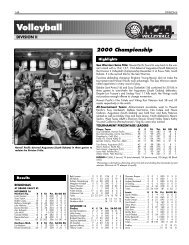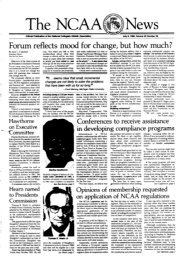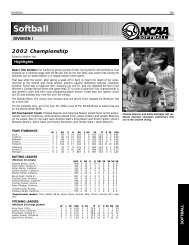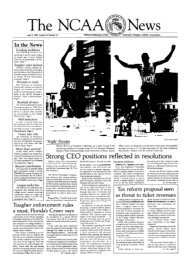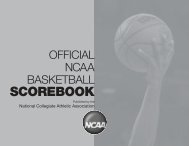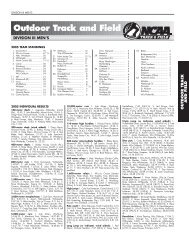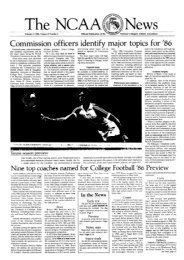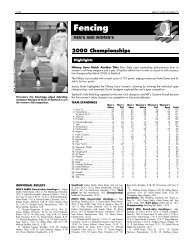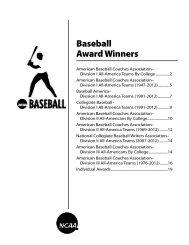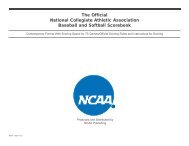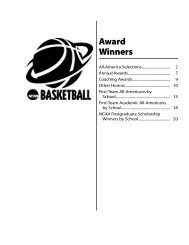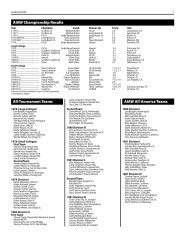Sports Medicine Handbook - NCAA
Sports Medicine Handbook - NCAA
Sports Medicine Handbook - NCAA
You also want an ePaper? Increase the reach of your titles
YUMPU automatically turns print PDFs into web optimized ePapers that Google loves.
24<br />
Preseason Preparation<br />
directly dependent on the level of<br />
fatigue driven by volume (quantity)<br />
and intensity of training. Similarly,<br />
the incidence in stress-related<br />
injuries (e.g., stress fractures,<br />
tendinitis) can be proportional to<br />
the work-rest ratio of the athlete.<br />
Preparatory Phase. The following<br />
are general concepts to consider<br />
during the preparatory phase of<br />
training:<br />
• Training should be periodized so<br />
that variation in the volume and<br />
intensity occurs in a scheduled<br />
manner.<br />
• Plan recovery to allow for growth<br />
and development while avoiding<br />
acute and overtraining injuries.<br />
• A proper heat acclimatization<br />
plan is essential to minimize the<br />
risk of exertional heat illness<br />
during the fall preseason practice<br />
period. Minimizing exertional<br />
heat illness risk requires<br />
gradually increasing athletes’<br />
exposure to the duration and<br />
intensity of physical activity and<br />
to the environment over a period<br />
of 10 to 14 days.<br />
• Prolonged, near-maximal<br />
exertion should be avoided<br />
before acquired physical fitness<br />
and heat acclimatization are<br />
sufficient to support high-<br />
intensity, long duration exercise<br />
training or competition.<br />
Fall Preseason Period. Institutions<br />
are encouraged to regularly review<br />
their preseason policies for fall sports<br />
and consider the following points of<br />
emphasis for protecting the health of<br />
and providing a safe environment for<br />
all student-athletes participating in<br />
preseason workout sessions.<br />
• Before participation in any<br />
preseason-practice activities, all<br />
student-athletes should have<br />
completed the medical<br />
examination process administered<br />
by medical personnel (see Bylaw<br />
17.1.5).<br />
• Institutions should implement an<br />
appropriate rest and recovery plan<br />
that includes a hydration strategy.<br />
• Preseason practice should begin<br />
with an acclimatization period for<br />
first-time participants, as well as<br />
continuing student-athletes.<br />
• During the acclimatization<br />
period, an institution should<br />
conduct only one practice per<br />
calendar day.<br />
• Practice sessions should have<br />
maximum time limits based on<br />
sport and individual needs, as<br />
well as environmental factors.<br />
• An institution should ensure<br />
student-athletes have continuous<br />
recovery time (e.g., three hours)<br />
between multiple practice sessions<br />
on the same calendar day.<br />
• Subsequent to the initial<br />
acclimatization period, an<br />
institution should consider a<br />
practice model that promotes<br />
recovery if practice sessions are to<br />
occur on consecutive days (e.g.,<br />
two-one-two-one format).<br />
• Student-athletes should be<br />
provided at least one recovery<br />
day per week on which no<br />
athletics-related activities are<br />
scheduled, similar to the regular<br />
playing season.<br />
• Coaches are encouraged to<br />
consult with healthcare staff (e.g.,<br />
athletic trainer) in the<br />
development of the conditioning<br />
sessions. All personnel should be<br />
aware of the impact of exercise<br />
intensity and duration, heat<br />
acclimatization, hydration,<br />
medications and drugs, existing<br />
medical conditions, nutritional<br />
supplements, and equipment on<br />
student-athletes’ health while<br />
participating in strenuous<br />
workouts.<br />
• Appropriate on-field personnel<br />
should review, practice and<br />
follow their venue emergency<br />
plan, as well as be trained in<br />
administering first aid,<br />
cardiopulmonary resuscitation<br />
(CPR) and AED use.



